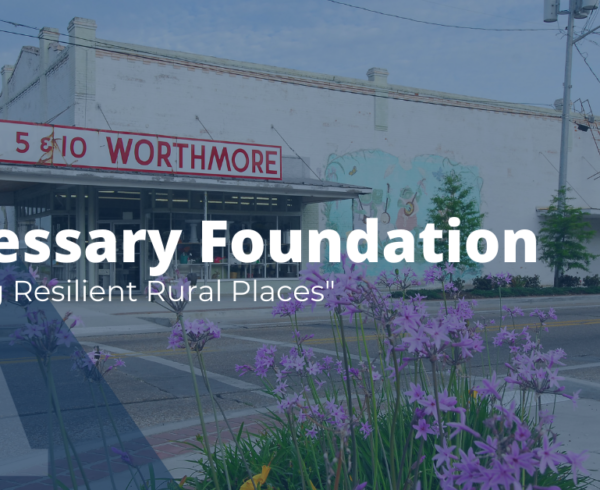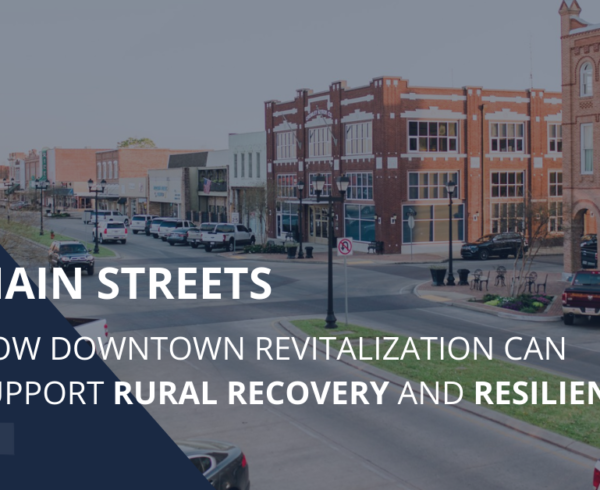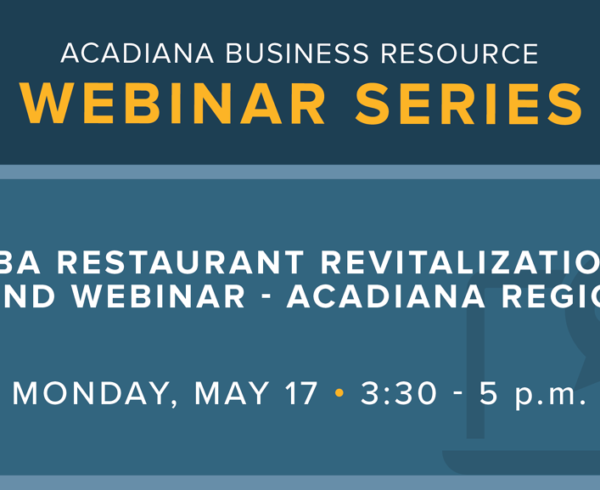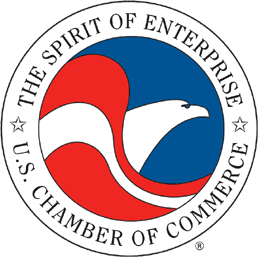The COVID small business crisis and prolonged and uneven, inflicting a disproportionate toll on microbusinesses in underserved communities that are the lifeblood of their local economies. While much attention has been paid to small business closures in urban communities across the country, the same dynamic is unfolding in underserved rural areas, with dire consequences.
Still rebounding from the Great Recession, rural small businesses entered the COVID crisis with compounding, preexisting vulnerabilities. Rural small businesses lack adequate access to capital and broadband connectivity, and are largely concentrated in the industries most immediately vulnerable to the pandemic’s effects. And just like in non-rural communities across the nation, minority-owned rural small businesses face heightened vulnerabilities, as structural racism and systemic economic exclusion compound barriers in capital access connectivity and access to relief. As rural communities grapple with these challenges, they will undoubtedly require coordinated relief to weather this crisis.
But as federal relief lags, it is imperative to also look locally for solutions—to identify and invest in local strategies that have long supported rural small businesses and can play an outsized role in recovery now. Prior to the pandemic, many rural communities were witnessing real successes in fostering small business growth and development through locally led downtown commercial corridor revitalization strategies. Often in partnership with Main Street programs and other place-based entities, these efforts are street-level solutions to community revitalization, designed to support small business development and an accessible entrepreneurial ecosystem rooted in local context. Now, as COVID exposes the economic instability of rural areas and rural small businesses in particular, the viability of these strategies is being tested in real time.
To understand the effectiveness of rural downtown revitalization heading into the COVID recession—and its potential for promoting rural recovery and resilience—this brief examines these efforts’ impact on rural small business growth, development, and success.
Why small businesses are a backbone for rural resilience
Despite callous assertions that rural economic stagnation is a natural result of progress (and short-sided commentary that moving to opportunity might be the only solution for rural residents), there is a collective imperative to improve economic health and opportunity in rural America. One in five Americans lives in rural areas, fostering deep ties and connections to the community. Rural places are stewards of the public land and natural resources our nation as a whole relies upon, and rural and urban economies have an interlocking, shared future. Moreover, rural leaders across the nation already have the skills—and in many cases are already using the tools at their disposal—to help their communities flourish.
Indeed, research suggests that as an alternative to traditional industry, rural areas can benefit from fostering a vibrant small business and entrepreneurship ecosystem, as rural small businesses have been found to generate wealth that stays in the community, build local leadership, and even contribute to population health. For decades, local actors, place governance organizations, and public officials have engaged in downtown revitalization strategies as a tool for nurturing rural small business development and economic growth. Main Street programs, in particular, have championed place-based revitalization strategies to leverage the density and proximity of rural commercial corridors to cultivate vibrant “regional hubs” that foster locally owned businesses, create employment centers for residents, and contribute to a sense of neighborhood identity that retains residents and attracts new ones. These strategies are meant to be holistic, designed not for a singular purpose of attracting tourism or preserving historic buildings or even growing businesses, but to bring to their communities the resources and amenities that national retailers and groceries often will not—and, ultimately, enhancing the quality of life and opportunity for residents that are often overlooked.
However, despite the widespread adoption of downtown revitalization strategies, relatively little is known about how these efforts can be scaled and adapted to a variety of rural contexts to achieve broad-based economic inclusion in rural America, how these efforts can withstand acute economic crisis, and how to support these efforts in the long term to ensure resilient and inclusive rural economies.
Can downtown revitalization help rural small businesses more durably recover from the COVID crisis and build resilience in the long term?
Three findings came about after interviewing 62 small business owners and other key stakeholders, in order to understand how downtown revitalization contributes to small business and economic development in rural areas. These findings are:
Finding 1: Through connection to place governance organization, downtown revitalization helps increase small businesses’ and entrepreneurs’ access to capital, skills training, and capacity-building supports—providing a critical foothold entering the COVID recession.
For decades prior to COVID-19, place governance organizations and partners in all three communities worked to connect underbanked small business owners and entrepreneurs downtown with greater access to capital and capacity-building resources. This laid the groundwork for small businesses to access supportive networks and services in the midst of the crisis. The primary mechanisms they employed to do so were:
Identifying nontraditional sources of capital investment: Over the last decade, downtown stakeholders have launched formal mechanisms to facilitate crowdsourced capital for entrepreneurs who struggled to obtain the right-size investment from traditional banks. Ideally, the community also became invested in the success of the participating small businesses. At the outset, these strategies were designed to raise capital for underserved small businesses, but ultimately they created a built-in base of local supporters invested in the success of these small businesses and provided a dedicated customer base and culture of supporting small businesses entering into the COVID-19 recession.
Training local financial institutions and filling in capital gaps: To improve relationships between community banks and downtown businesses, Main Street programs regularly conducted training with local banks. For underserved small businesses who still lacked access to capital, they offer a revolving loan fund available to entrepreneurs and conducts intentional outreach to underserved Latino- or Hispanic-owned businesses to increase the diversity of business ownership downtown. These efforts to cultivate relationships between community banks, small businesses, and Main Street organizations fostered the connectivity, trust, and access to institutional resources that underserved small businesses would not have otherwise had—providing a pathway for small businesses struggling during the pandemic to reach out for help.
Providing skills training and tailored capacity-building support: In all the communities, Main Street offices provided tailored capacity-building support and direct counseling to help small business owners refine their business plans, obtain loans, and contemplate business transitions. There were regular reports about how Main Street helped businesses owners navigate bureaucratic processes. These direct counseling and training supports have continued amid COVID-19. Moreover, research indicates that connections between Main Street small business owners are, in fact, helping them collaborate to adapt business operations, offer promotions, and weather the economic downturn.
Finding 2: Downtown revitalization helps connect small businesses with low-cost, low barrier-to-entry incubator spaces, and with the relationships needed to mitigate rent costs amid COVID-19.
Many rural downtowns hold assets of historic building stock downtown—offering aspiring business owners relatively low-cost retail space in historic, walkable downtowns. Yet, for those entrepreneurs who struggled to rent their own commercial spaces, Main Street programs and other downtown stakeholders offered incubator spaces and “launch pad” programs to cultivate business creation by offering reduced-cost commercial space and built-in business counseling and support.
 Businesses are offered reduced rents that slowly escalate over an 18-month tenure, as well as access to no-cost fiber internet and phone service. Main Street programs such as a “Made on Main” program are aimed at placing small manufacturers in vacant downtown spaces to help them grow, access resources, and interact with other small business owners through selling their products in the locally owned food co-op or working with farmers market vendors. And as small business owners struggle with rent payments amid the pandemic-induced recession, local Main Street organizations have been working with landlords and property owners to identify potential solutions.
Businesses are offered reduced rents that slowly escalate over an 18-month tenure, as well as access to no-cost fiber internet and phone service. Main Street programs such as a “Made on Main” program are aimed at placing small manufacturers in vacant downtown spaces to help them grow, access resources, and interact with other small business owners through selling their products in the locally owned food co-op or working with farmers market vendors. And as small business owners struggle with rent payments amid the pandemic-induced recession, local Main Street organizations have been working with landlords and property owners to identify potential solutions.
Finding 3: Through cross-sectoral collaboration, downtown revitalization enhances rural small businesses’ access to city, regional, and state resources—a critical connective tissue in times of crisis.
The most salient role that downtown place governance organizations played in promoting small business development and resilience is serving as a liaison for small businesses in city, state, and regional structures—striving to leverage cross-sectoral partnerships to not only enhance city investment downtown, but also to connect small businesses to their broader regional economy.
Serving as the connective tissue for accessing city and state resources: Local Main Street programs act as a liaison between downtown business owners, city officials, and state officials to ensure small business owners had access to resources at multiple levels of governance. At the city level, this requires forming partnerships with city officials, being aware of city funds, participating in citywide economic development plans, and serving as a constant advocate for downtown interests. This liaison role has continued (and taken on added urgency) amid the COVID-19 pandemic, as Main Street organizations in all three communities advise small business owners on grant applications for state and federal resources.
Leveraging partnerships with regional entities: Main Street organizations also strive to improve connectivity between small businesses and regional institutions, including universities and major regional employers. Through one partnership, downtown businesses are able to bring on university students as interns at no cost to the business owner, with the cost of student labor covered through grant funds and universities. Additionally, through the Start Your Own Business course mentioned above, local entrepreneurs benefit from the expertise of faculty, among others. As COVID-19 reductions in tourism hit these communities particularly hard, it will be critical to continue partnerships with regional universities to leverage their institutional resources to help community recovery.
Conclusion
In rural and urban places alike, place-based organizations are being called on to play an expanded role in supporting small businesses amid COVID-19. They are rapidly modifying their work to assist businesses with applications for relief funding, redirecting existing funding streams to create new resources for relief, offering “shop local” campaigns, and engaging the public around businesses’ needs.
Through this research series, Brookings demonstrates how local leaders are not only playing an outsized role to ensure small business survival during this time of crisis, but are implementing holistic strategies to build rural resilience in the months and years to come. They are championing built environment and quality-of-life improvements, strengthening social ties between neighbors, and nurturing new civic structures to advance community priorities. True national economic recovery depends on recognizing the value of this work and of empowered rural community leaders working to tackle place-based inequities and foster inclusive, vibrant, and connected rural places in the long term.
This blog post is the third in a series titled “Building Resilient Rural Places.” The information found on this post, as well as all the post in the series, comes from a collection of reports done by Brookings. To see the full text of this report, along with links to their other reports, click here.













